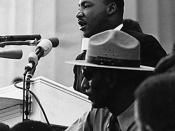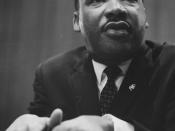When looking back on the Sixties, one of the most dominating themes of that period was the Civil Rights Movement. The quest for civil rights had been started long ago, when the black man was freed from the bonds of slavery. Over a hundred years later, the problem of blacks being treated as second-class citizens still persisted. What could be done to correct the present situation? Some, both blacks and whites, believed that non-violence was the only means to achieve civil rights, as Dr. Martin Luther King, Jr. preached. Others like Huey Newton of the Black Panthers believed that violence was the only way. And lastly, some agreed with both ways to achieve this end; whatever means guaranteeing civil rights must be taken. This last approach is the main focus of this essay. Both Stokely Carmichael and Malcolm X were dominant figures of their times. Whites, as well as some of the "moderate" black leaders, criticized both of them as "extremists" and "racists."
Certainly, their philosophy and approach to dealing with racism was quite different to the prevailing theme of working together with whites, within the system. Both Carmichael and Malcolm X shared similarities and minor differences in each of their philosophies. Most of all, the elements of "black pride" and "black militancy" manifested themselves in each of their approaches. However, the stereotypes against these more "extremist" movements have long trickled down among the generations in a negative light. In attempting to unravel the stereotypes of "black pride" and "black militancy," an open-minded reading of both Carmichael's Black Power and The Autobiography of Malcolm X unclouded the truth and meaning behind the more "radical" approaches during the Civil Rights Movement.
Important in understanding the philosophies of both Carmichael and Malcolm X is each man's background. Carmichael was a well-educated individual...


